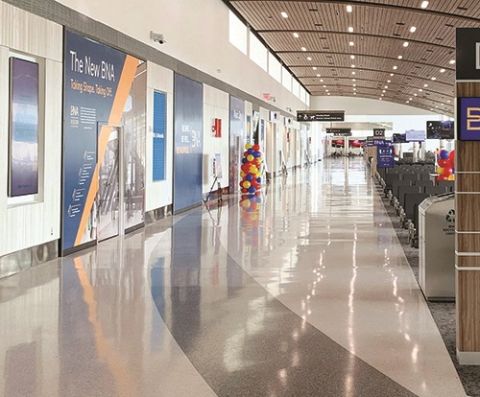New Concourse at Nashville Int’l Updates City’s Front Door, Facilitates More Expansion & Renovations

The new Concourse D at Nashville International Airport (BNA®) didn’t just add gate capacity and new customer amenities. It is also facilitating future expansion to help the Tennessee airport cope with years of explosive growth in passenger volume. Operations from elsewhere at BNA have moved into the new concourse to allow remodeling and construction of other areas.
The 115,000-square-foot concourse, opened last summer, includes six domestic aircraft gates occupied by Southwest Airlines, several art displays and upgrades requested by customers, such as more power outlets. The $292 million, 25-month construction project also expanded BNA’s ticketing lobby and baggage claim by adding 200,000 square feet of space to the north and south ends of the terminal. Moreover, crews remodeled 136,000 square feet of existing terminal space and built an 11,000-square-foot central utility plant.
Concourse D is an important component of BNA Vision, a $1.4 billion capital improvement program slated to wrap up in 2023. Other key elements will include three terminal garages with a total of 6,800 covered parking spaces, additional space for ticketing and baggage claim, renovations in the terminal lobby, an expanded security checkpoint, a new international arrivals facility, additional concessions space, an airport administration building, pedestrian plaza, hotel and a potential transit connection.
|
facts&figures Project: New Concourse & Wing Expansions Location: Nashville Int’l Airport Owner: Metropolitan Nashville Airport Authority Cost: $292 million Funding: Bonds Construction: June 2018-July 2020 Design Architect: Corgan Design-Build Team: Hensel Phelps & Fentress Architects
Architecture Support: Jenny Mac Creative; Cost Estimator: Cape Civil Engineer/Landscape Designer: S&ME Geotechnical: Langan; Terracon; KS Ware & Associates Inc. Structural Engineer: Logan Petri Engineering; Magnusson Klemencie Associates Mechanical/Electrical/Plumbing Engineer: IC Thomasson Associates Inc.; DFH Services
Fire/Life Safety: Wiss, Janney, Elstner Commissioning Agent: Smith Seckman Reid Inc. Technology/Integration: EJO Ventures Technology: Burns Engineering; Win Engineering; Johnson Controls Signage & Graphics: Jones Worley Common-Use Equipment: Amadeus
Boarding Pass/Bag Tag Printers Operational Database & Resource Management System: Amadeus Dynamic Glass: SageGlass Seating With Power Ports: Zoeftig |
Doug Kreulen, president and chief executive officer of the Metropolitan Nashville Airport Authority, explains that multiple years of double-digit growth caused BNA officials to assess the current and future needs of the airport. In 2015, the airport signed a new airline agreement and “things were accelerating so fast with year-over-year growth that we knew we had to develop a longer plan, a better plan, for how to handle this growth,” he recalls.
While many 20-year airport master plans assume 3% annual growth, BNA was easily tripling that in consecutive single years. “You realize you can’t keep up,” Kreulen reflects. “That’s how the BNA Vision was formulated.”
In 2019, the airport served nearly 18.3 million passengers.
Preparing for Growth
The biggest planning challenge was determining what the airport would need to meet the growth, explains Kreulen. The six-year, $1.4 billion plan that was developed includes everything from additional gates, parking and concessions to expanding the road network to help passengers get to and from the airport. Overall, the capital improvement program is designed to increase BNA’s annual capacity from 18 million to 36 million passengers.
As with any major undertaking, preparation and careful planning were critical. “It was a big puzzle for us the first three years,” Kreulen recalls. “Like Legos or Lincoln Logs, you have to figure out how to move stuff out of the way before you can get to where you really want to work.” For BNA, that meant beginning work on the North and South Terminal Wings, including Concourse D, so flight operations can relocate there while crews work on the center of the airport. The middle section of the airport closed in January for approximately three years for additional renovations and construction. Crews will expand the TSA checkpoint from 10 lanes to 24, extend the post-security recollection area and add new retail and concessions. New retail and food/beverage options will be added to the area leading to the international gates for the convenience and benefit of international passengers—a customer segment that may be growing soon. “We want our international customers to land at the front door of the airport so that they’re downtown within 30 minutes,” adds Kreulen.

Supporting the growth of Southwest Airlines at BNA was paramount to the entire project, he advises. “Southwest has a large portion of Concourse C, and in order to encourage them to continue to grow in Nashville, we wanted to provide them with additional gates so that they could continue to keep making their quick turn-times and maximize the use of their facilities and their aircraft.”
Thus, Concourse D is large enough to allow for simultaneous pushbacks by 737s from all six gates without adversely impacting Concourse C operations. “It turned out to be a win-win,” says Kreulen.
A New Front Door
Once it was clear that BNA’s dominant carrier would be satisfied with the new facility, the priority became outfitting the concourse to reflect the feel of middle Tennessee. “We wanted it to be warm and welcoming—so people are excited when they land, but are also wanting to come back when they depart,” Kreulen explains.
That task fell to the Hensel Phelps and Fentress, the design/build team for Concourse D and the terminal wings project.

Curt Fentress, principal in charge of design at Fentress Architects, notes that airport officials wanted a new front door for Nashville that reflects the city’s sights, sounds, tastes—everything that makes it a great music city. “I think it’s an important aspect of an airport today that it is exciting and memorable and relates to the place,” says Fentress.
To that end, designers specified taller wood ceilings to give the new space an open, airy and natural feel. Floor-to-ceiling glass floods the concourse with natural light and allows full views of the airfield. “There’s a lot of wood used in the finishes,” he remarks. “And the way the building opens up provides a lot of views to the airfield so you can sense the excitement of travel.”
A strong art program also contributes to the visual appeal, Kreulen adds. “It’s calming and adds a lot of beauty to the airport.”
Suspended over the node of Concourse D, Lyrical Journeys is a 90-foot-long interactive light sculpture that pays homage to the sights and sounds of Nashville. It includes 14 pairs of steel bridge plates and 20 liner strings of LED lights that brighten and darken in rapid succession as passengers walk beneath the sculpture, creating the impression that they are strumming the light strands as if they were a piano or guitar. “It’s really beautiful,” says Kreulen.

At the south end of the new concourse, a large vinyl record mosaic called Every New Day is the Best Day of Our Lives represents the history of music in Nashville. The photorealistic neon piece includes colors similar to Southwest’s familiar corporate palette. “It’s a vibrant, exciting piece to be seen,” says Fentress.
Art cases between the new concession spaces display work from BNA’s $1.5 million collection that rotates throughout the airport.
The design team combined artwork, live music and wood finish materials to evoke the feeling of Tennessee. “We warmed up the aesthetic and made it much more interesting,” says Fentress.
New amenities include free Wi-Fi, more power outlets for charging personal electronics, updated terrazzo flooring, an indoor service animal relief area, a nursing room for mothers and bottle refilling stations at every water fountain—upgrades requested by passengers, Kreulen notes.
 These elements help make the facility feel more pleasant and friendly, adds Fentress. “It’s not so utilitarian as airports have been in the past.”
These elements help make the facility feel more pleasant and friendly, adds Fentress. “It’s not so utilitarian as airports have been in the past.”
The new concourse has space for nine concession operators, but only one was filled as of mid-December. “We were turning over all that new space to the concessionaires, and then the pandemic hit,” Kreulen recalls. “They had 120 days to build out, and the bottom line was that everybody locked down, had to wear masks, nobody could come to work. Basically, they lost all of their construction loans and were worried about their overall financial health; so nobody took any risks.”
While Concourse D does have concession kiosks in place, Kreulen laments the lost opportunity associated with not having full build-outs. As passengers traffic returns, BNA expects to amend its concessions agreements and move forward bringing in operators. Currently, the space is blocked off with sheetrock covered with graphics and renderings. “It’s coming,” Kreulen says. “I think the same time next year it will all be full.”

Benefits of Sustainability
Concourse D achieved Silver certification through the Leadership in Energy and Environmental Design (LEED) program. Sustainable components include recycling receptacles, energy-efficient lighting, water conservation systems, electrochromic glass to block out excessive sunlight and heat, geothermal cooling and an emphasis on using regional labor.
Kreulen notes that the LEED elements are cost-effective as well as environmental—and containing costs recently became even more important than usual. “We were doing something that we would be proud of but that would also save us money in the long run,” he explains. “And now the pandemic comes and everybody is trying to figure out ways to cut costs.”
Several major systems make the concourse “energy-efficient beyond belief,” he adds. For instance, as natural sunlight intensifies during the day, dynamic glass from SageGlass dims automatically to reduce glare and minimize the amount of air conditioning needed to keep the temperature comfortable. Cool 51-degree water from a local quarry is piped in under one of the runways for a geothermal cooling system that saves the airport millions of dollars annually.

Project Partnership
Airport executives took particular care to assure Southwest that the Concourse D project would not impact BNA’s existing airline agreements. “Once we understood what their needs were and designed this, we always included their executive team in the decisions we were making,” says Kreulen. “But also we proved to them that we would not have to raise our fees. We honored our commitment, stayed on schedule, stayed on budget, and we haven’t passed the burden onto the airlines. And that’s something to be proud of.”
The airport successfully sold $920 million in bonds in December 2019, allowing funding for the project to be firmly in place prior to the pandemic. Although Southwest is the sole airline tenant in Concourse D, all of the airport’s key tenants and business partners are playing vital roles in the technical advisory group for BNA Vision.
The airport’s partnership with its tenants was, and will continue to be, crucial—especially during construction. Common-use passenger processing equipment from Amadeus has allowed BNA to reshuffle airlines to clear the way for work crews. It also partnered with Amadeus to implement an Airport Operational Database and Resource Management System to plan, schedule and allocate airport resources.
2022 Charlotte Douglas International Airport Report of Achievement
 Giving back to the community is central to what Charlotte Douglas International Airport and its operator, the City of Charlotte Aviation Department, is about, and last year was no different.
Giving back to the community is central to what Charlotte Douglas International Airport and its operator, the City of Charlotte Aviation Department, is about, and last year was no different.
Throughout 2022, while recovering from the COVID-19 pandemic, we continued our efforts to have a positive impact on the Charlotte community. Of particular note, we spent the year sharing stories of how Connections Don't Just Happen at the Terminal - from creating homeownership and employment opportunities to supporting economic growth through small-business development and offering outreach programs to help residents understand the Airport better.
This whitepaper highlights the construction projects, initiatives, programs and events that validate Charlotte Douglas as a premier airport.
Download the whitepaper: 2022 Charlotte Douglas International Airport Report of Achievement.








